Festive spice and roses
Celebratory sweets
Being given a mithai (sweetmeat) box heavy with the weight of its contents as a gift always filled my childish heart with sweet anticipation. This treat would be a box of celebratory sweets announcing a happy occasion and its significance goes to the very heart of Pakistani culture. A child is born, a union blessed – nothing goes unsweetened.
At weddings, large baskets decorated with roses and brimming with silver leaf-decorated mithai are given as gifts between the families and trays adorned with cardamom-scented ladoos are fed to the bride and groom by well-wishers as an act of welcoming a new family member. On Eid, sheer khurma infused with saffron and rich dried fruit is offered as a welcoming drink to guests, and on passing exams parents shower friends and family kewra-laced gulab jamuns and barfi.
Festive desserts are a labour of love, heavy with spice, and watching them being cooked is a sight to savour. Massive stainless-steel cooking pots are constantly stirred as they are filled with milk slow-cooked to a clotted cream consistency, then sweet fruits or vegetables with kilos of sugar are added and exotically spiced with saffron, kewra, cardamom or cloves. Hours are spent making sweets or pouring out individually decorated servings. The happier the occasion, the sweeter the offering.
In Pakistan, no dawwat (feast) can be without a large platter of decadent desserts, perfumed mithais or halvas – this practice is engrained in Pakistani cultural hospitality as a way of sharing joy with loved ones.
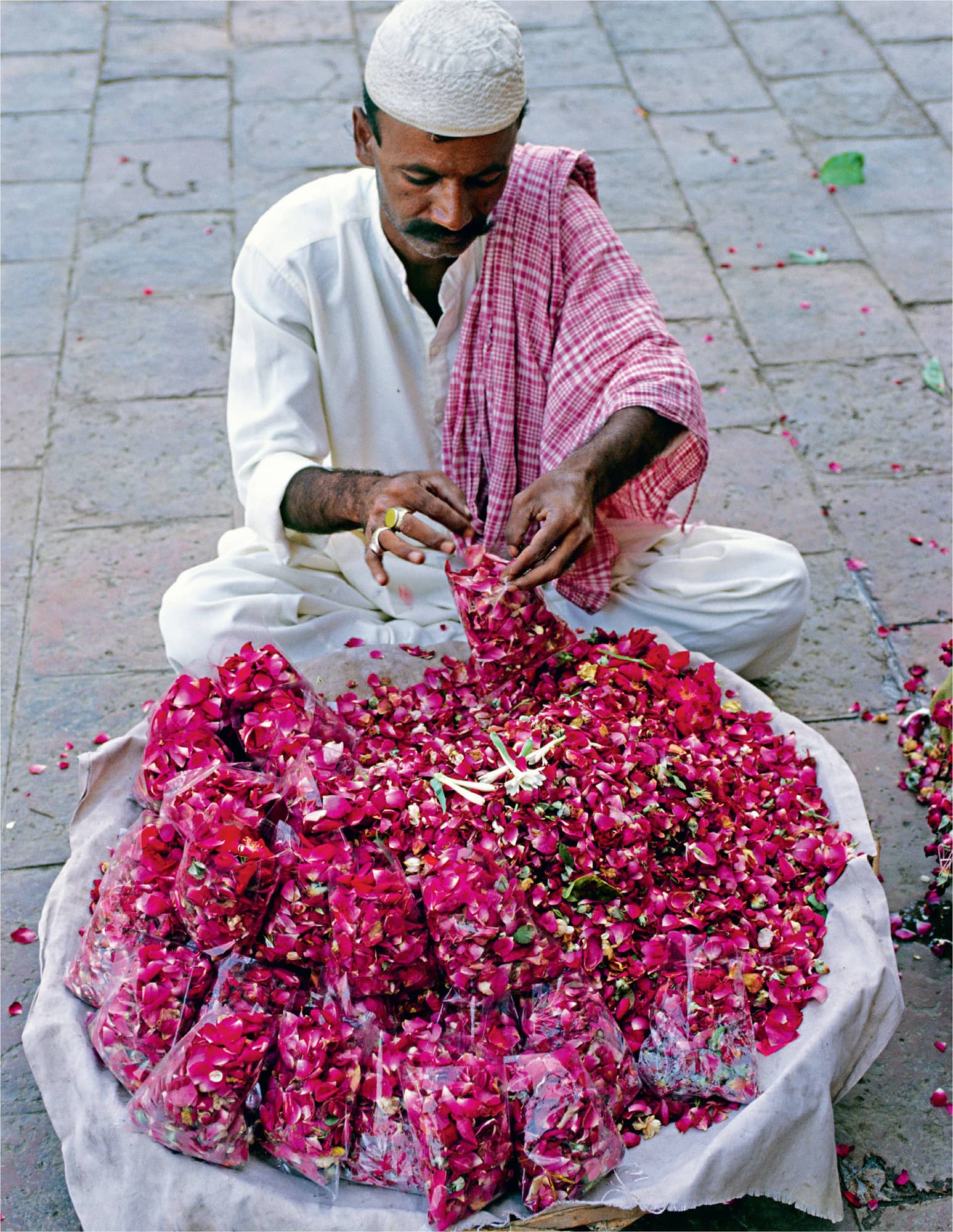
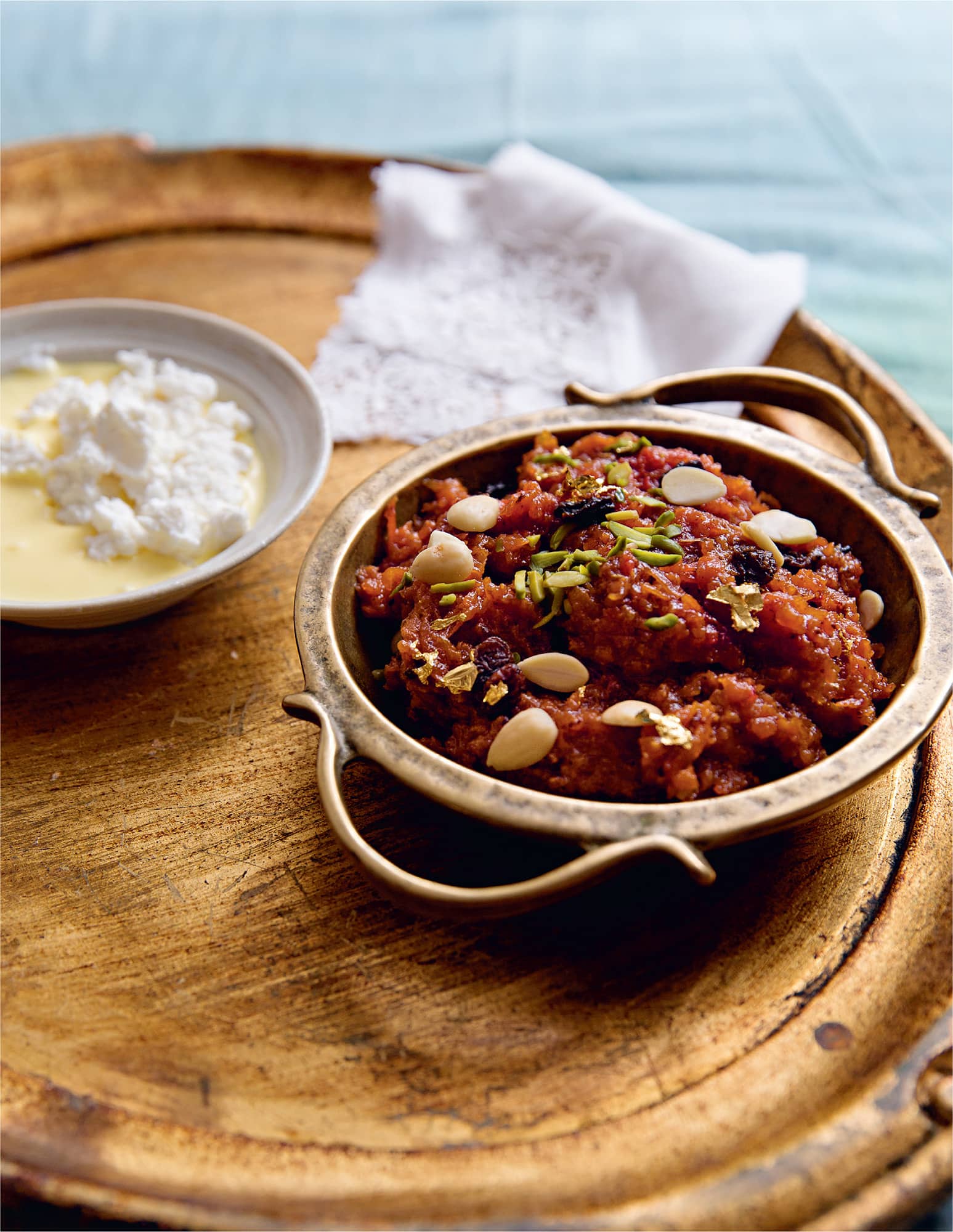
◁ Gajar ka halva
Carrot halva served with whipped cream
Carrots in Pakistan are deep red, sweet and intensely crunchy. They are a winter vegetable, so this dessert is a favourite at wedding dinners during cooler months. Many families have their own secret recipe for gajar ka halva that goes back generations. This one is my Dadi’s (paternal grandmother) and has been adapted by my mother. The slow cooking intensifies the infusion of cloves and saffron, which combines with the intensity of the sweet carrots as this halva bubbles away to a rich, shiny fruition. This is the ultimate Pakistani celebration dessert.
Preparation 25 minutes | Cooking 1 hour | Serves 6–8
100ml/31/2 fl oz/scant 1/2 cup whole milk
400ml/14 fl oz/13/4 cups double (heavy) cream
500g/1 lb 2 oz/33/4 cups carrots, grated
5–6 cloves
5 cardamom pods, seeds removed
100g/31/2 oz/1/2 cup caster (superfine) sugar
a generous pinch of saffron threads
2 tbsp desiccated (dry unsweetened) coconut
1 tbsp roughly ground pistachios
natural red food colour (optional)
whipped cream or vanilla ice cream, to serve
To decorate
1 tbsp raisins
1 tbsp flaked (slivered) almonds
1 tbsp slivered pistachios
2 sheets gold leaf
Bring the milk and cream to the boil in a heavy-based saucepan, add the grated carrots, cloves and cardamom seeds and cook over a medium–low heat, stirring occasionally, for about 25–30 minutes until the milk and cream are absorbed into the carrot. Keep an eye on the it in case it starts to burn or stick on the base of the pan.
Now add the sugar and saffron, keep stirring until it is thoroughly mixed in. Stir in the coconut and ground pistachios.
Once the halva is thick and deep red (you can add a little red food colour if the carrots are a bit pale) and all the cream/milk and sugar is absorbed, pour it into a serving dish and decorate with raisins, almonds, pistachios and gold leaf. Serve warm or cold with whipped cream or ice cream.

◁ Balushahi
Festive glazed curd doughnut
These flaky pastry-like doughnuts are fried and then dunked into a spiced sugar syrup. They are always the best surprise in celebratory mithai (sweetmeat) boxes. Although these are traditionally flavoured with saffron, I have created an unusual mix of turmeric, black cardamom and vanilla for the syrup in this recipe.
Preparation 25 minutes + 45 minutes resting | Cooking 25 minutes | Makes 10–12
For the doughnuts
200g/7 oz/11/2 cups plain (all-purpose) flour
1/4 tsp salt
1/4 tsp bicarbonate of soda (baking soda)
60g/21/4 oz/1/4 cup ghee
6 tbsp whole plain chilled yogurt
vegetable oil, for deep-frying
For the sugar syrup
240ml/8 fl oz/1 cup water
375g/13 oz/2 cups caster (superfine) sugar
1/4 tsp ground turmeric
1 black cardamom pod
1/2 tsp vanilla extract
2 tsp lemon juice
To decorate
2 tbsp white poppy seeds
First, make the doughnuts. Put the flour, salt and bicarbonate of soda into a large bowl and stir to combine. Next, add the ghee and, using your fingers, mix together until it resembles coarse crumbs. It takes a good 1 minute to get this texture. Add the yogurt and knead just enough until all the ingredients come together. Cover the dough with a wet muslin cloth and allow to rest for about 30 minutes at room temperature.
Divide the dough into 10–12 equal portions, the size of large lemons, and make a dent in the centre of each with your thumb. Try not to press too much while shaping them as this can cause them to crack. Cover the dough portions with a wet cloth and allow them to rest for another 15 minutes at room temperature.
Heat the oil for deep-frying in a deep saucepan to 180°C/350°F, or until a cube of bread browns in 30 seconds. Once the oil is hot, start adding a few balls at a time into the oil and fry them over a medium heat. The medium heat helps the balushahi to cook evenly from the inside. As soon as the dough balls float to the surface, flip them over and fry until the bottom half is dark golden brown. Once both sides are well browned, remove with a slotted spoon and drain on kitchen paper. Continue with the rest of the dough balls.
For the sugar syrup, heat the water, sugar, turmeric, black cardamom pod and vanilla together in a saucepan over a medium heat, stirring well until the sugar dissolves and the mixture comes to the boil.
Turn the heat to low and simmer until it is at the double thread stage (see here). Then add the lemon juice to stop the syrup crystallising.
Dip the fried doughnuts, one at a time, into the sugar syrup, making sure they are coated all over and arange them on a serving platter. Decorate the balushahi with white poppy seeds and allow to rest until the sugar hardens.
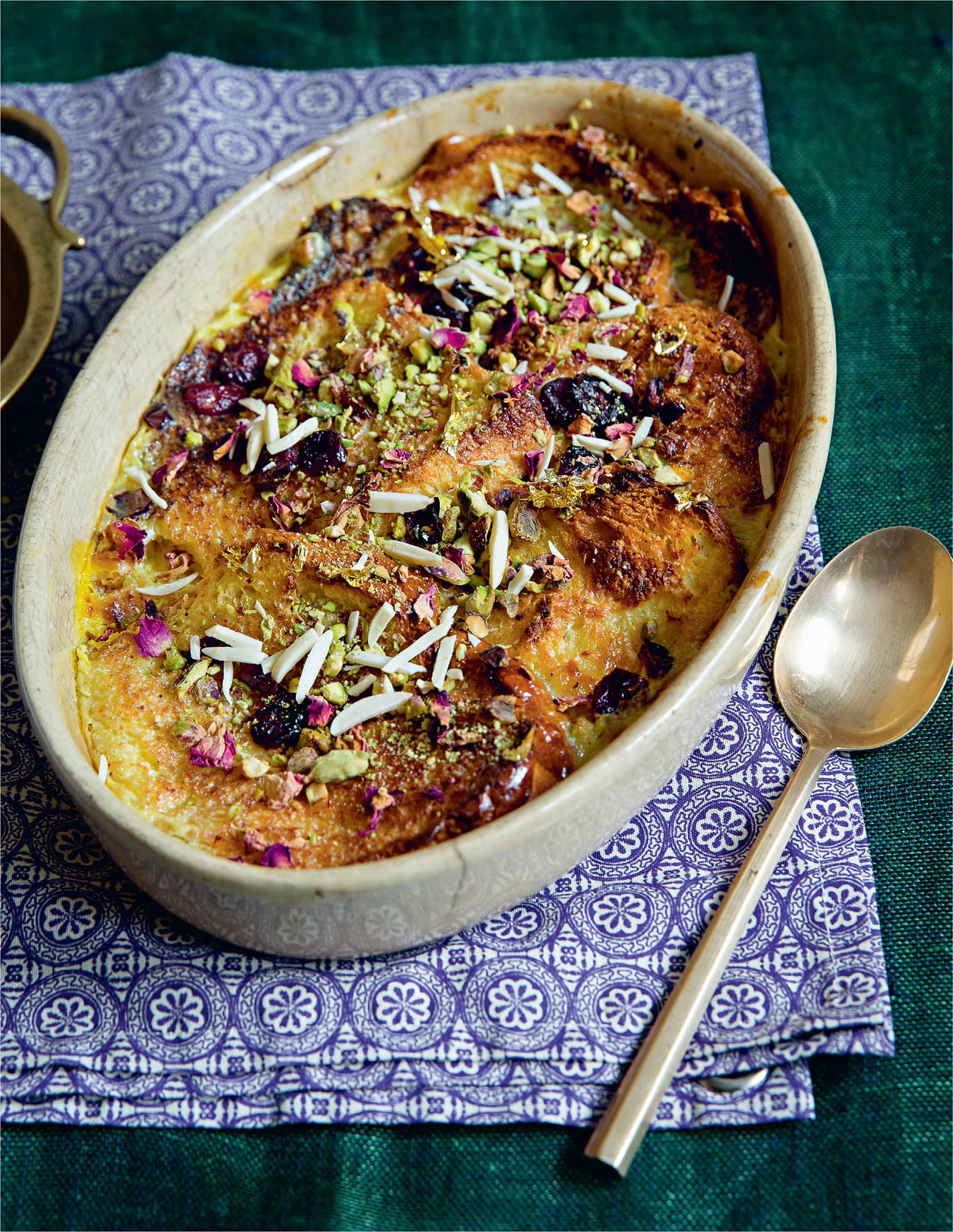
◁ Shahi tukra brioche bread pudding
with saffron, ricotta, cranberries and chopped nuts
This is a festive bread pudding with a history that goes as far back as the Mughal emperors, but I have updated it by using sweet brioche bread to add a rich flavour. This dessert can either be baked or unbaked and served chilled or warm.
Preparation 25 minutes + chilling | Cooking 30 minutes | Serves 6–8
1 litre/13/4 pints/4 cups whole milk
250ml/9 fl oz/generous 1 cup condensed milk
a pinch of saffron threads
4 cardamom pods, seeds removed and finely crushed
150g/51/2 oz/2/3 cup ricotta
3 tbsp ghee or unsalted butter
10 slices of brioche loaf, cut in half
handful of chopped pistachios, almonds, pine nuts, dried cranberries, cherries and raisins
dried rose petals
gold or silver leaf
Put the milk, condensed milk, saffron and cardamom together in a heavy-based pan and bring to the boil over a low–medium heat. Turn the heat down to low, add the ricotta, stir until smooth (tiny lumps may remain, which are fine) and cook for 10 minutes until thick. Take the pan off the heat and set aside.
Heat 1 teaspoon of the ghee in a pan, add a brioche slice and fry until it is toasted on both sides. Transfer the brioche to an ovenproof dish and repeat frying all each slice of brioche in 1 teaspoon of ghee.
Pour the milk mixture over the brioche and decorate with nuts, berries and raisins. At this point you can either refrigerate or bake in an oven preheated to 180°C/350°F/gas mark 4 for 15–20 minutes until golden brown.
Scatter rose petals over the top and adorn with gold or silver leaf to serve.
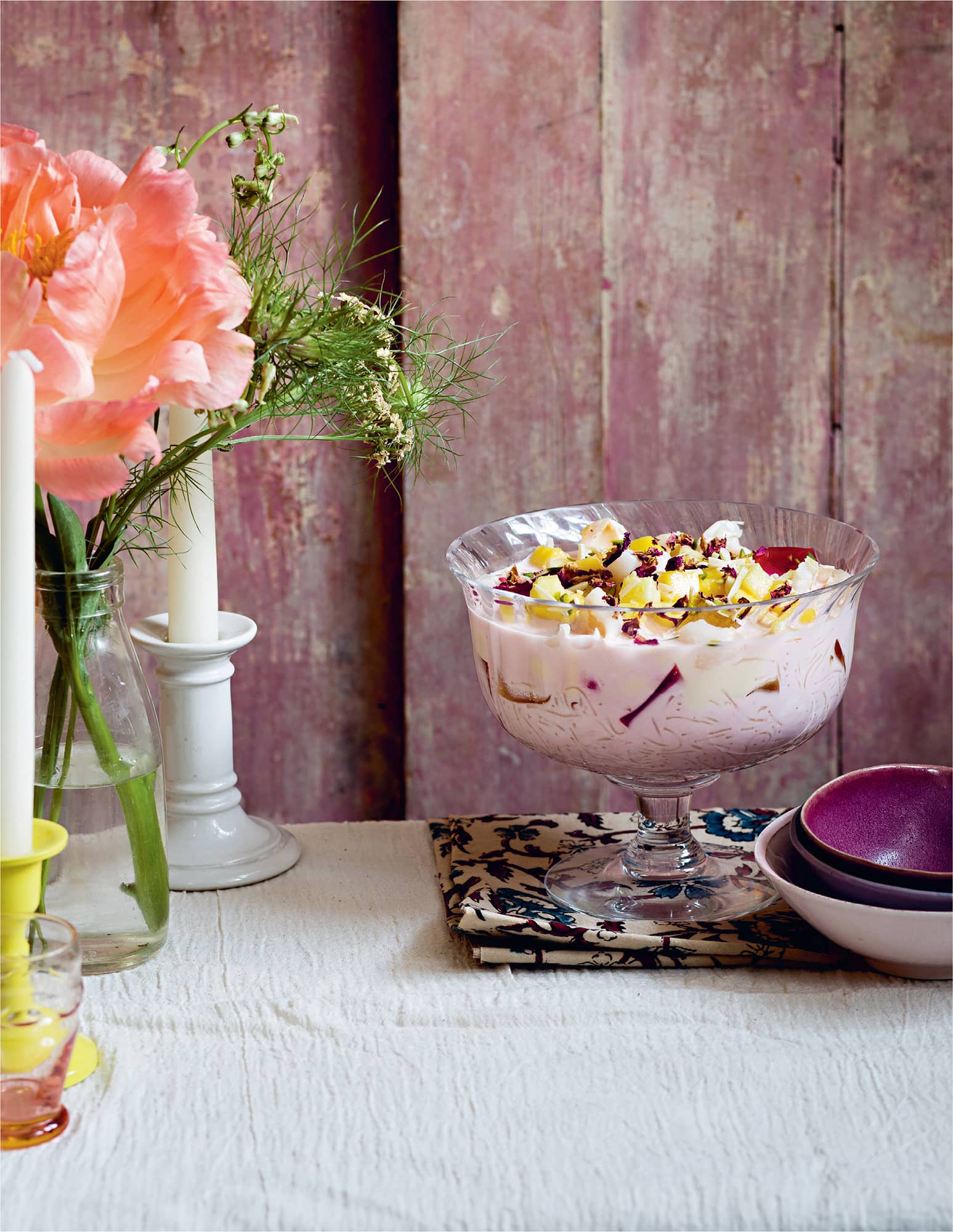
◁ Rose lab-e-shireen
Pakistani trifle with lychee, mango, cardamom milk and vermicelli
This eye-catching dessert is made in large stainless-steel platters and sold by the kilo. It is a hotchpotch of Pakistani sweet flavours – seasonal fruit, rose, cardamom, jelly, sweet vermicelli and Rooh Afza rose syrup. Its vibrant colours and its many textures are captivating. A Karachi favourite with Arab roots, it is a great celebratory dessert.
Preparation 20 minutes + 2 hours chilling | Cooking 10 minutes | Serves 6–8
2 packets of 2 different flavoured jelly crystals
500ml/17 fl oz/2 cups whole milk
2–3 cardamom pods, seeds removed and finely crushed
a handful of plain or coloured vermicelli
150ml/5 fl oz/2/3 cup ready-made custard
1 mango, roughly chopped
6–8 canned or fresh lychees
2–3 tbsp rose syrup
To decorate
2 tbsp chopped pistachios
1 tbsp roasted blanched almonds
1 tbsp dried rose petals
Begin by preparing the jelly according to the packet instructions and chill in the fridge for 2 hours, or until set. Remove the jelly and cut into icecube-sized squares. Place in the fridge.
Next, make the cardamom milk. Bring the milk and cardamom to the boil in a saucepan. As soon as it is boiling, turn off the heat, allow to cool, then transfer to the fridge.
Cook the vermicelli in a saucepan of boiling salted water for 5–8 minutes until soft, then drain and set aside.
When ready to assemble the dish, begin by placing the cooked vermicelli at the base of a large glass serving bowl. Next, add the jelly cubes, then the ready-made custard, then pour over the cardamom milk and top with some of the fruit pieces. Drizzle with the rose syrup and swirl it so that it colours the milk pink, then decorate with chopped pistachios, almonds, rose petals and the remaining fruit. Serve chilled.
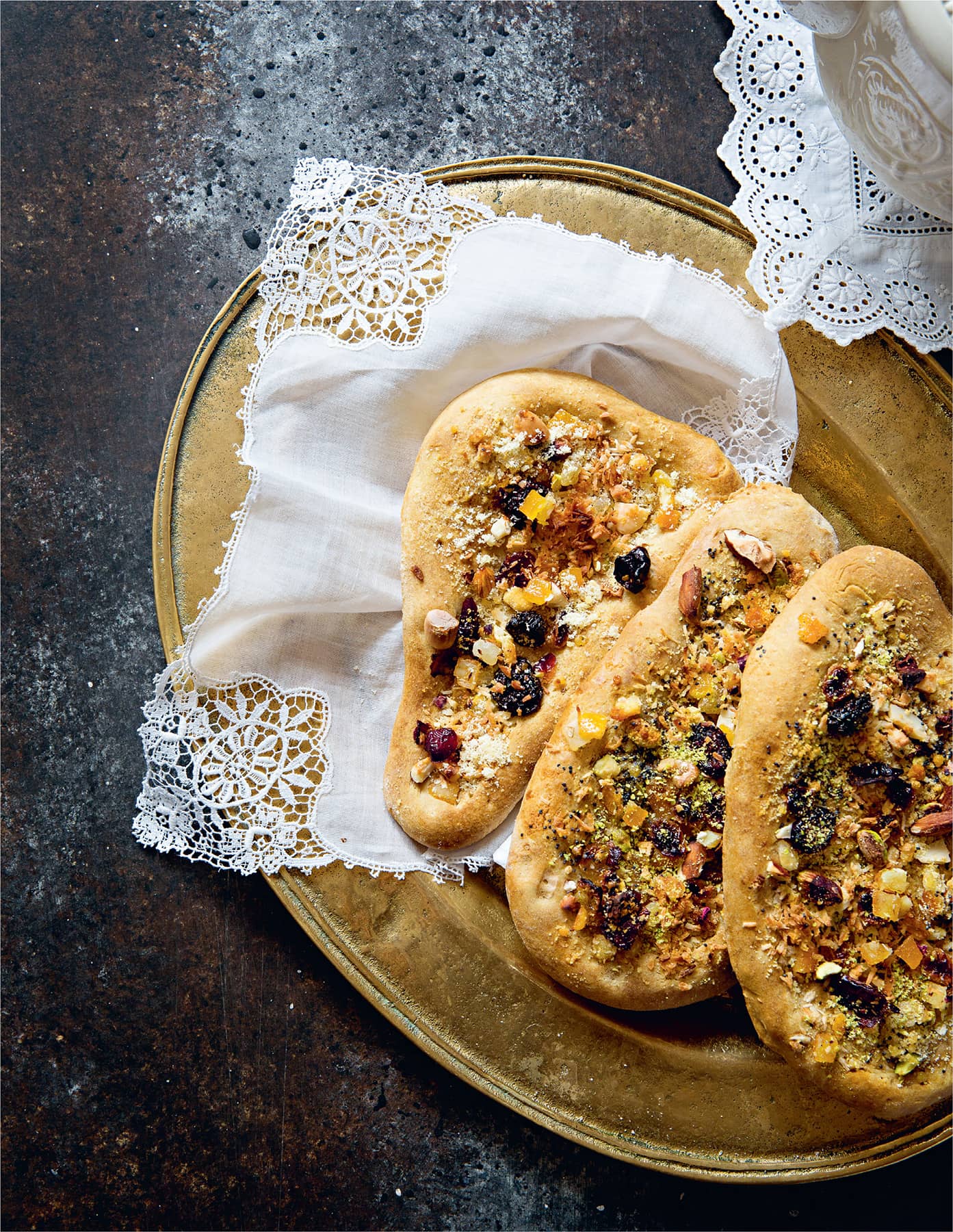
◁ Meva naan
Sweet bread with dried fruit
A sweet celebration naan bread, which is delicious dipped in a cup of chai after a long, spicy festive meal. Serve them as soon as they are cooked.
Preparation 30 minutes + 1–3 hours rising | Cooking 15 minutes | Makes 7–8
For the naan
320g/111/4 oz/21/4 cups strong plain (all purpose) flour, plus extra for dusting
1 tsp baking powder
1/4 tsp bicarbonate of soda (baking soda)
a pinch of salt
2 tsp soft brown sugar
1 egg, beaten
2 tbsp ghee, plus extra for coating and brushing
100ml/31/2 fl oz/scant 1/2 cup whole plain yogurt, beaten
150ml/5 fl oz/2/3 cup whole milk, or as needed during kneading
choice of seeds, spices, fresh herbs and dried fruit, for sprinkling
Sift the flour, baking powder, bicarbonate of soda, salt and sugar together into a large bowl. Make a well in the middle and pour in the beaten egg and ghee and, using your hands, work the dough into a ball. Add the yogurt and the milk (you may need a little more) and knead until it is a smooth dough. (If using a stand mixer, place all the dry ingredients, egg and yogurt in the bowl and pour the milk in gradually while the mixer kneads with a dough hook. Knead until a dough is formed.)
Coat the dough lightly with a little ghee, then cover with a damp tea towel and allow to rise in a warm place for at least 1 hour, or up to a maximum of 3 hours. The dough should have risen, but not quite doubled in size.
Knead the dough again briefly on a lightly floured surface, then divide it into 7–8 small round balls. Using a rolling pin, roll the dough into an oblong naan shape with tapering ends, then pierce all over with a fork. Brush the naans lightly with ghee and sprinkle over your choice of seeds, spices, fresh herbs and dried fruit.
Preheat the oven to 200°C/400°F/gas mark 6 or preheat the grill to high. Heat a dry heavy-based non-stick frying pan over a medium heat. When hot, slap on the naan and cook gently until it is lightly browned on the bottom, then transfer the naans to a baking tray and slide onto the shelf of the hot oven or grill. Cook the naans for 4–5 minutes, or until they rise and little brown air pockets form on the top. Serve.
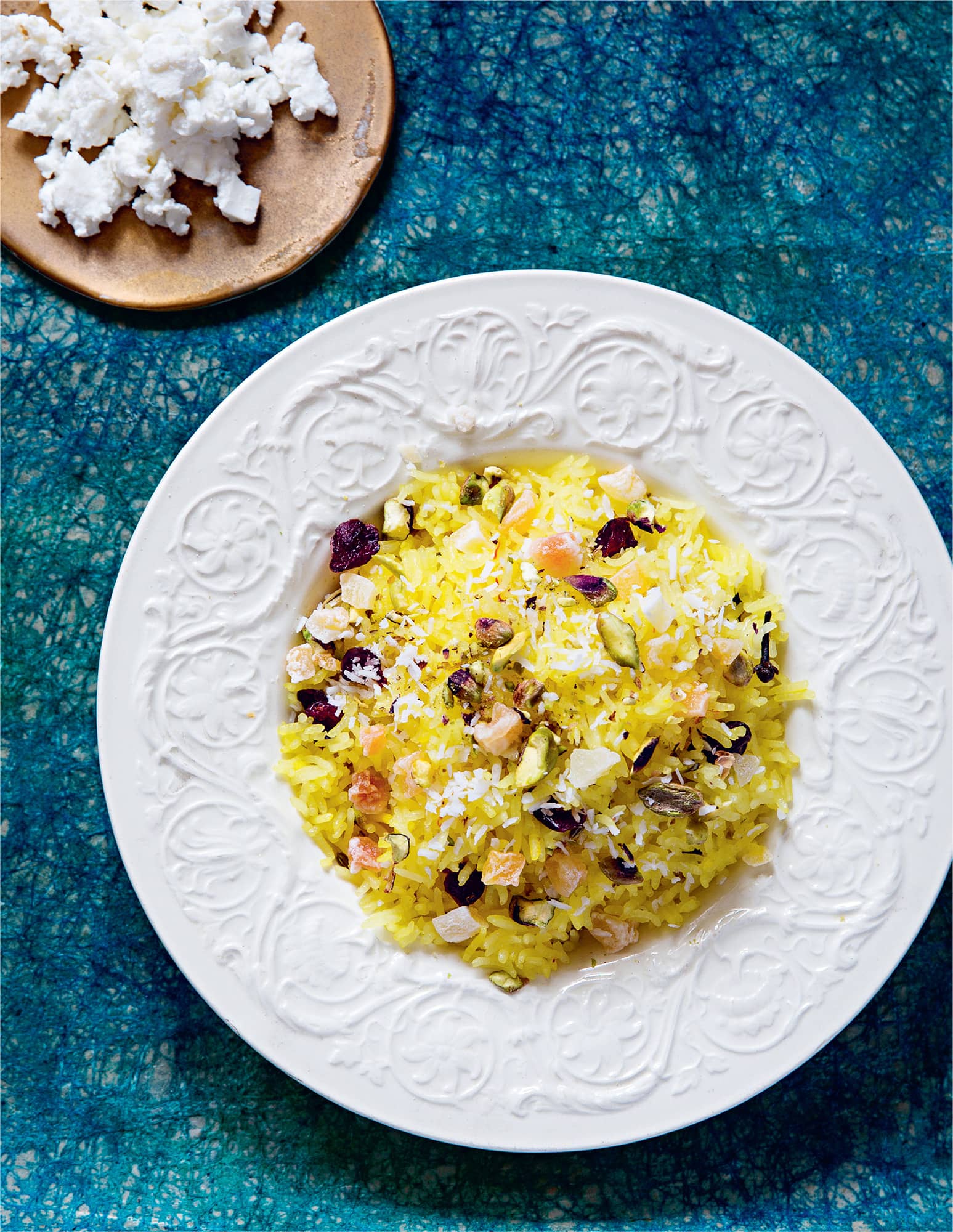
◁ Saffron-infused zarda
Sweet rice with nuts, coconut, candied fruit and khoya
Glistening in shades of tangerine and pale rust, sweet saffron rice can be a festive dessert, a teatime snack and sometimes an accompaniment to savoury dishes, or eaten as an appetiser.
Preparation 10 minutes + 30 minutes soaking | Cooking 30 minutes | Serves 4–6
a large pinch of saffron threads
1 tsp hot water
8–10 cloves
5–7 cardamom pods
275g/91/4 oz/12/3 cups basmati rice
2 tbsp ghee
350ml/12 fl oz /11/2 cups water
300g/101/2 oz/12/3 cups caster (superfine) sugar
1 tbsp pistachios
1 tbsp pine nuts
1/2 tbsp chopped candied peel or candied papaya
To decorate
1 tbsp glacé (candied) cherries, chopped
1 tbsp desiccated (dry unsweetened) coconut
4 tbsp khoya / milk fudge
Soak the saffron in the hot water for 30 minutes. Fill a saucepan with enough water for cooking the rice, then add 3–4 cloves and 3 cardamom pods and bring to the boil. Add the rice and par-cook for 2 minutes, then drain and set aside.
Heat the ghee in a dry saucepan, add the remaining cloves and cardamom pods, the measured water and sugar, and make into an single thread syrup (see here).
Add the par-cooked rice and nuts, and stir. The water should just about cover the rice. Cover the saucepan with a lid and turn the heat down to low. Check every 5 minutes, stir gently and cover again. Keep doing this until the rice is nearly cooked through.
Once the rice is nearly done, pour in the saffron, keep the heat on low and cook, covered, for a few more minutes. The rice should be completely cooked through but not over-soft or mushy.
Serve in a bowl topped with candied peel, glacé cherries, desiccated coconut and khoya.
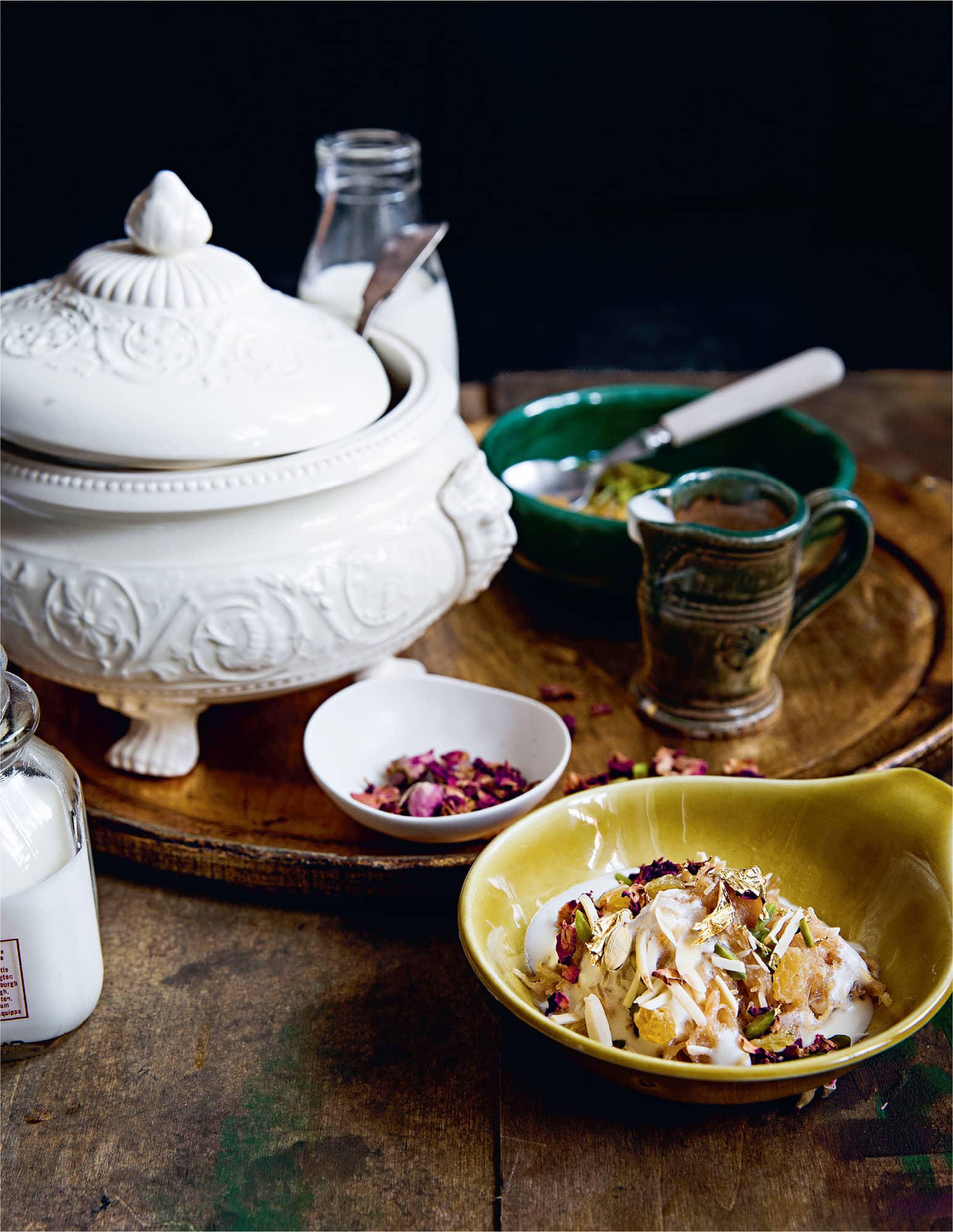
◁ Qawwami seviyan
Roasted vermicelli topped with nuts
Eid is a time of celebration and enjoying all things decadent. Seviyan is a quintessential Pakistani Eid dessert, which is served as a welcoming sweetness to guests visiting on the day. Every family has their own recipe and this is one that has been in my father’s side of the family for generations. Qawwami seviyan is a sugar preserved roasted vermicelli dessert that’s eaten with cream or milk. My Dadi (paternal grandmother) would make it traditionally with one part seviyan to 16 parts sugar, but now my mother makes it with less sugar. Served best with malai clotted cream.
Preparation 15 minutes + 20 minutes soaking | Cooking 1 hour | Serves 8–10
a pinch of saffron threads
1 tbsp hot milk
4–5 tbsp ghee
4–5 cardamom pods
5–6 cloves
150g/51/2 oz/1 cup broken dry seviyan (vermicelli)
350g/12 oz/2 cups caster (superfine) sugar
175ml/6 fl oz/3/4 cup water
1 litre/13/4 pints/4 cups whole milk
ice-cold or warm milk or cream, to serve
To decorate
3 tbsp flaked (slivered) almonds
3 tbsp slivered pistachios
2 tbsp sultanas (golden raisins)
sliver or gold leaf, or rose petals (optional)
Soak the saffron in the hot milk for 20 minutes.
Heat the ghee in a small frying pan over a medium heat, add the cardamom pods and cloves and fry until fragrant. Once the aroma develops, add the seviyan and fry, stirring to make sure that the seviyan does not burn but slowly turns a light brown colour. You might have to keep moving the pan off the heat and stirring to make sure it doesn’t burn.
In another pan, heat the sugar and water together until the sugar has dissolved and you have a single thread syrup (see here). Add the fried seviyan to the sugar syrup and mix.
Now add most of the milk, slowly, and stir until combined. Keep the pan over a low heat and cover with a lid until the milk is absorbed and the seviyan is cooked completely. Check on it every couple of minutes, you may need to add more milk. Once cooked and soft, add the saffron, then pour the seviyan into a serving bowl and allow to cool.
Sprinkle with nuts and sultanas and decorate with silver leaf and/or rose petals. Refrigerate until ready to serve with ice-cold or warm milk or cream. Store in the fridge for up to a week, or in the freezer for months. It is great for breakfast.
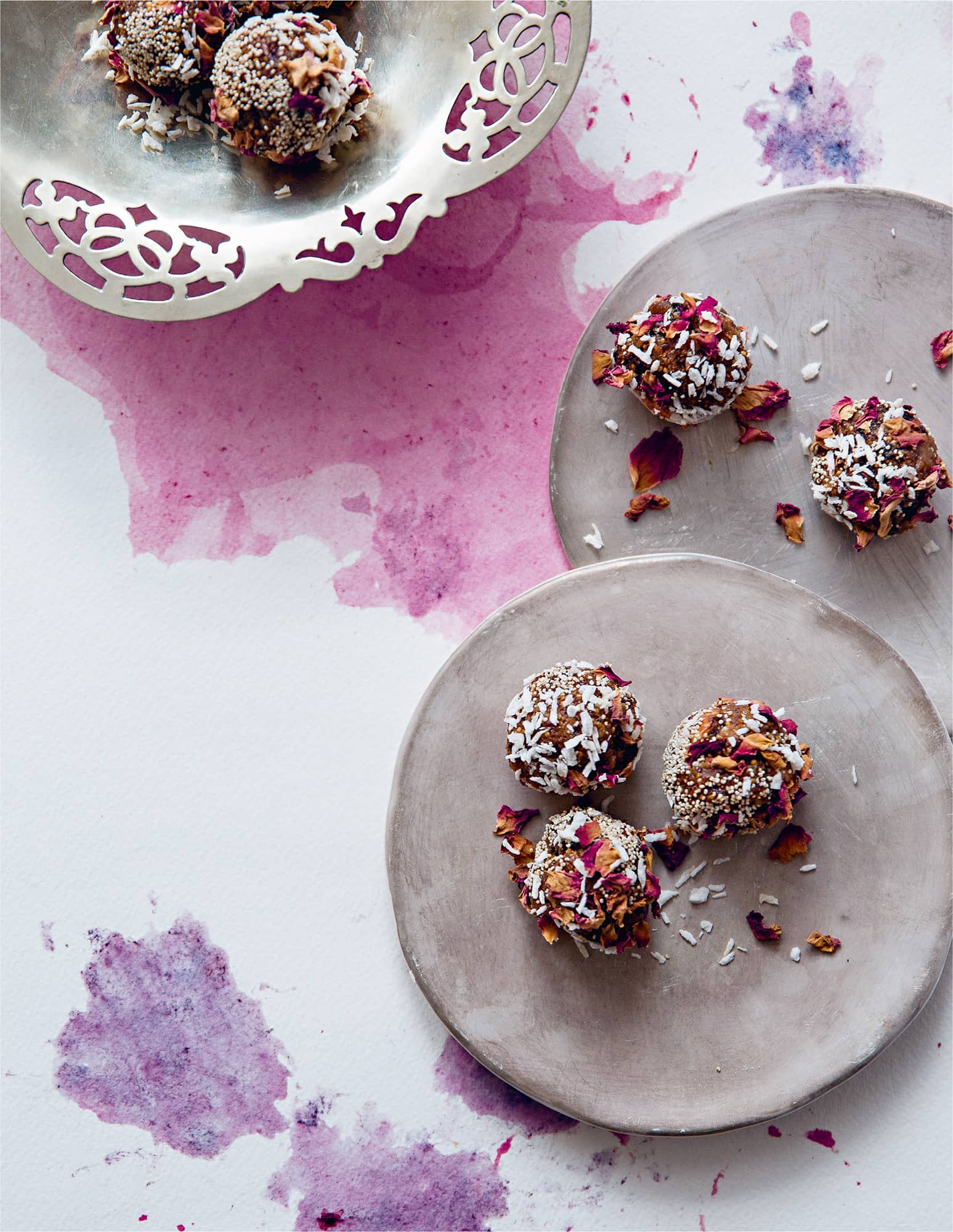
◁ Spiced and floral truffles
with dates, apricots, walnuts and pistachio
What keeps my daughter Ayaana grounded to her roots are the flavours of Pakistani cooking. I learnt much of my cooking by osmosis and it appears she is doing the same, which is why it wasn’t a surprise when, at seven years old, she made up this recipe. Fun when made with little hands.
Preparation 20–25 minutes + 30 minutes chilling | Makes 6–8
10g/1/4 oz/scant 11/2 tbsp walnuts
10g/1/4 oz/scant 11/2 tbsp unsalted pistachios
100g/31/2 oz/2/3 cup soft dates, pitted
20g/3/4 oz/scant 1/4 cup soft dried apricots
30g/1 oz/2 tbsp butter, melted
1 cardamom pod, seeds removed and finely ground
1 tsp rose water
4 tbsp condensed milk
3 tbsp desiccated (dry unsweetened) coconut, finely ground
To decorate
2 tbsp dried pink rose petals
1 tbsp desiccated (dry unsweetened) coconut
1 tbsp finely ground pistachios
Blitz the walnuts roughly in a food processor and set aside, then blitz the pistachios roughly and set aside separately.
Add all the main ingredients to a food processor with the ground nuts and blend until combined. Cover and chill in the fridge for 30 minutes.
When ready to make, take a heaped teaspoon of the cooled mixture and form it into a small ball, then roll it in a mix of rose petals, coconut and ground pistachios.
Serve immediately or store in an airtight container in the fridge for 1 week.
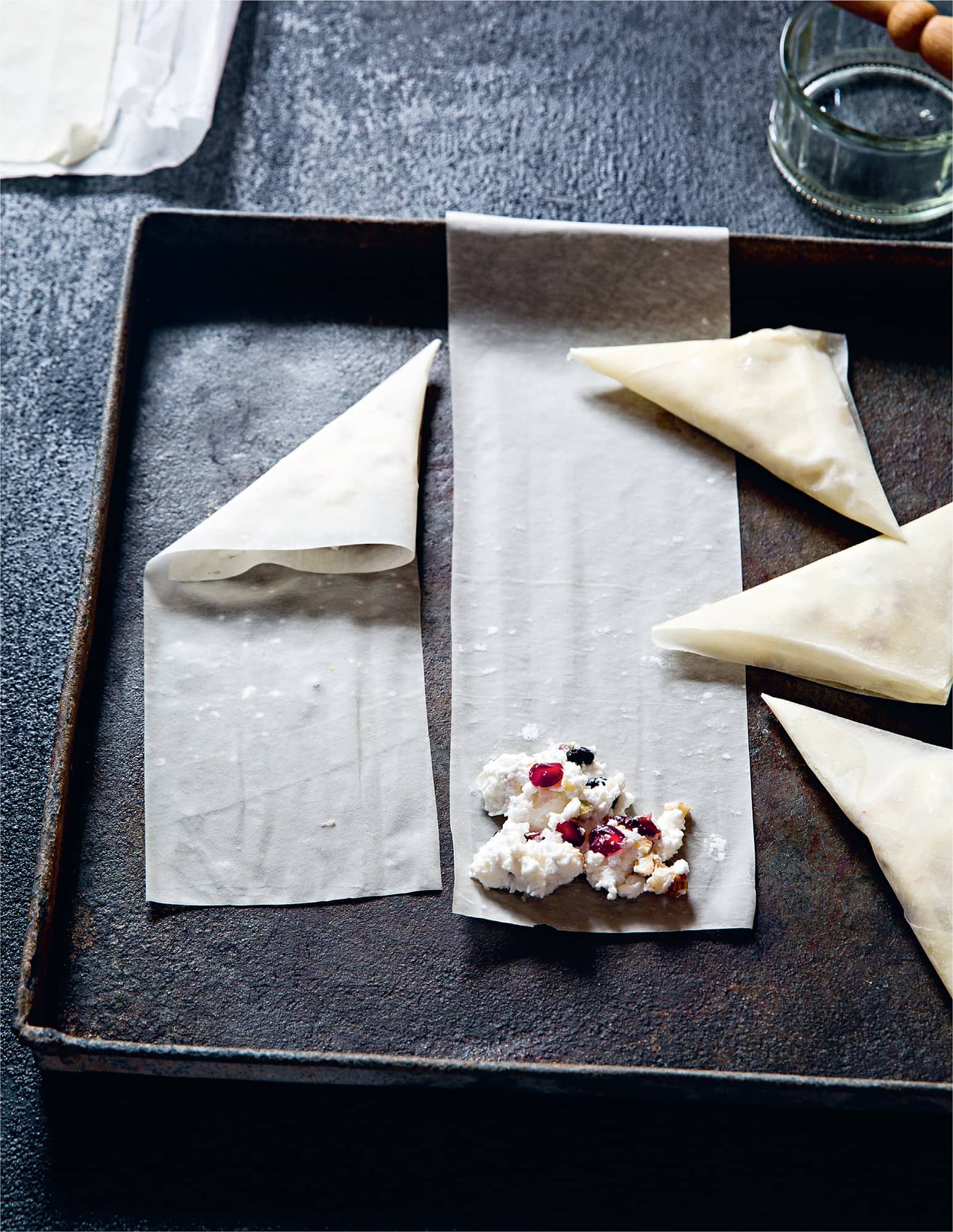
◁ Milk fudge filo samosas
with coconut, cloves and pomegranate
I remember getting tiny crescent-shaped sweet parcels from friends celebrating Hindu festivals, and I always relished them. Traditionally these sweet samosas are called gujia, but here is my quick version using filo pastry and a filling made with homemade khoya (milk fudge), pomegranate seeds, desiccated coconut and poppy seeds.
Preparation 20 minutes | Cooking 15 minutes | Makes 8–9
130g/4 oz of filo (phyllo) pastry
150g/51/2 oz khoya / milk fudge
50g/13/4 oz desiccated (dry unsweetened) coconut, lightly toasted
1 tbsp poppy seeds, lightly dry-roasted
50g/13/4 oz/1/3 cup pomegranate seeds
1 tbsp blackcurrants
1/2 tsp ground cloves
a little ghee
about 100ml/31/2 fl oz/scant 1/2 cup vegetable oil, for shallow-frying
whipped cream, to serve
Cut the filo pastry into 25cm/10-inch long x 5cm/2-inch wide strips and keep them covered under a damp tea towel so they don’t dry out.
Mix all the remaining ingredients, up to and including the cloves, together in a bowl.
Begin to make the samosas by taking 2 filo sheets, brushing a little ghee on one side and sticking over the other. There is no need to grease the second sheet. Now with the narrow side facing you, add 1–2 teaspoons of the filling on one side, then begin to turn over to form a triangle. Keep repeating until you are left with a samosa-shaped pastry. Seal the end with a little ghee and repeat until all the filling and filo pastry is used up. Keep the samosas covered until ready to fry.
Heat the oil for shallow-frying in a frying pan and fry the samosas in batches for 3 minutes or so on each side until light brown and crispy. Remove with a slotted spoon and drain on kitchen paper. Keep warm in a foil pouch.
Serve hot with whipped cream.
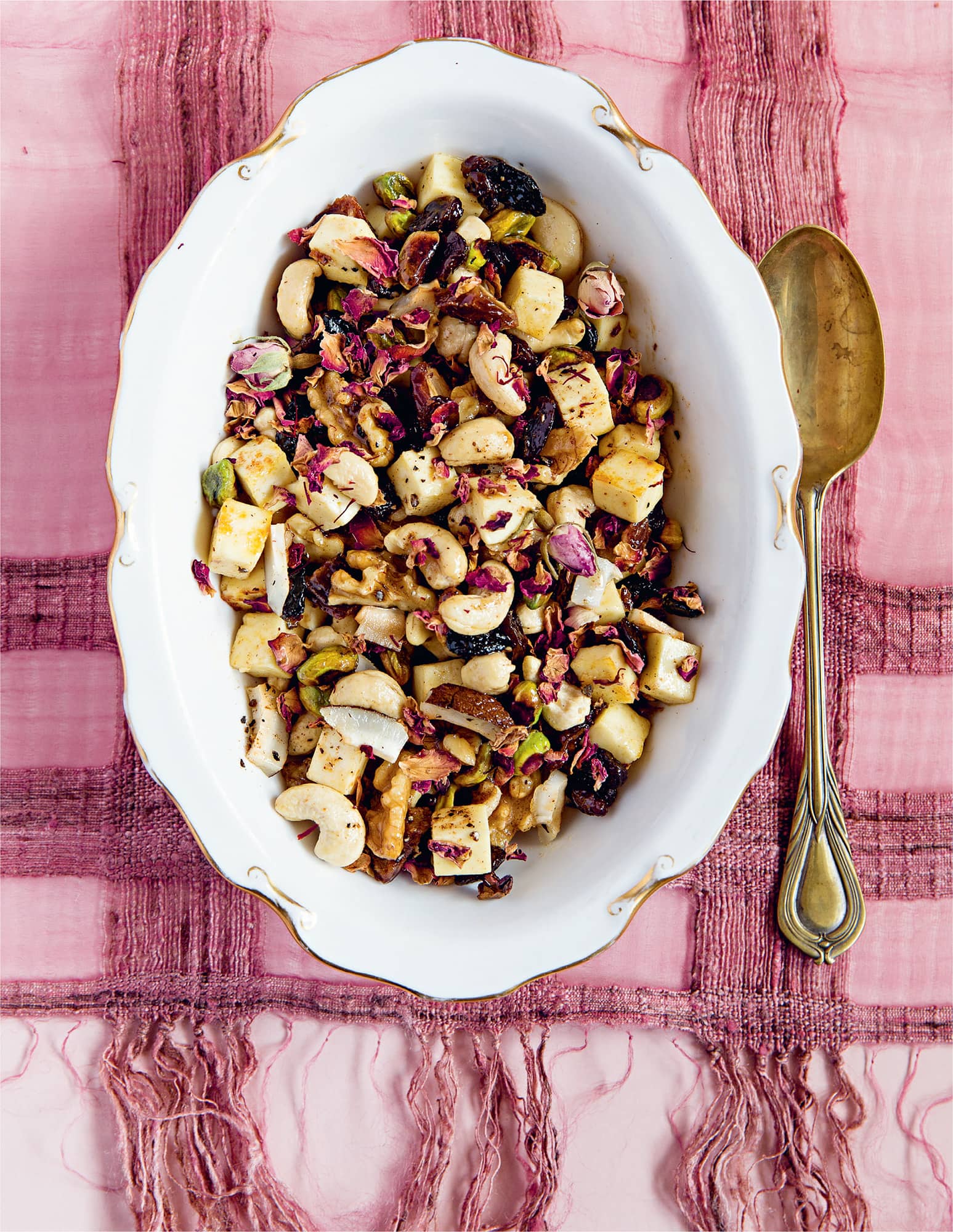
◁ Kashmiri shufta
Paneer cheese with floral spiced nuts
Dried fruits and paneer cheese are coated extravagantly with spiced rose sugar syrup, making this an irresistibly exotic Kashmiri festive offering. This is one of my favourite celebratory recipes.
Preparation 20 minutes + 20 minutes soaking | Cooking 20 minutes | Serves 6–8
7–8 dried dates, pitted and chopped into 4 pieces
2 tbsp ghee
100g/31/2 oz firm paneer, cut into small squares
120g/41/4 oz/1 cup unsalted pistachios
60g/21/4 oz/1/2 cup walnuts
115g/4 oz/scant 1 cup blanched almonds
40g/11/2 oz/1/3 cup pine nuts
80g/3 oz/2/3 cup cashews
50g/13/4 oz fresh coconut chunks
120g/41/4 oz/scant 1 cup sultanas (golden raisins)
400g/14 oz/21/4 cups golden caster (superfine) sugar
2 tbsp water
For the spices
4–5 cardamom pods, seeds removed and ground
1/2 tsp ground black pepper
1/2 tsp ground cinnamon
1/2 tsp ground nutmeg
1/2 tsp ground ginger
a large pinch of saffron threads
1/4 tsp ground cloves
2–3 tbsp dried rose petals
Soak the chopped dates in a bowl of hot water for 20 minutes. Drain and place them on kitchen paper to soak up any excess water.
Heat 1 tablespoon of the ghee in a frying pan and fry the paneer until light golden brown on all sides. Remove from the pan and set aside.
Using the same pan, heat the remaining ghee and fry all the nuts, then fry the dried dates, coconut chunks and sultanas. Place them together with the fried paneer.
Heat the sugar and water together in another saucepan over a medium heat until the sugar dissolves. Once the sugar syrup begins to bubble, add all the spices and rose petals then add all the fried nuts, raisins and cheese.
Toss quickly to coat everything in the syrup and serve immediately.